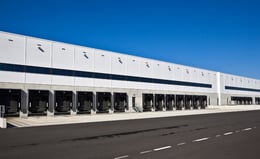Functional Silos Are Dragging Down Your Supply Chain
Nick Ostdick - March 08, 2016

Think about the concept of a silo and you very quickly realize why farmers and those in the agriculture industry rely on them: they’re big, can hold a lot of grain or corn in one place at one time, and make it easy for trucks to move large quantities of product at one time. Great for a farm, but bad for supply chain logistics which depend on speed, agility, and accuracy, and that’s why functional silo supply chain structures are usually to blame when overhauling in efficient and cost-prohibitive supply chain practices.
Challenges of Coordinating Product Promotions
To put this in perspective, I was recently talking with a supply chain manager for an automotive parts manufacturer who discussed the challenges of coordinating product promotions with the sales department in order to ensure enough inventory to meet demand. Information about special sales initiatives was often ill-relayed, if at all, and sudden spikes in demand due to special offers often resulted in small supply chain disruptions when it came to filling and transporting orders.
The Problem of Vertical Supply Chain Structures
This SCP's struggles are not uncommon in today’s supply chain landscape and are indicative of the functional silo problem whereby supply chains are structured vertically as opposed to horizontally. This paradigm inhibits supply chain transparency, agility, and resiliency, each of which on its own can be the death nail for making quick, cost-effective supply decisions.
For example, most automotive manufacturing companies are comprised of: manufacturing, procurement, logistics, marketing, and sales. Each department has its own specialty, agenda, and goals, and coordination of these goals and benchmarks are very rarely aligned. Even though each of these entities has a critical function in creating a productive end-to-end supply chain experience, information and data is often passed one department at a time almost like a game of a telephone where crucial data points can morph and evolve. This can increase the potential for error and possible disruption along various points of the supply chain. In addition, this is time consuming and in most cases the conditions and details have changed before it reaches all of those required to make an informed decision.
Ramifications of Functional Silos in Global Supply Chains
The ramifications of functional silos in today’s global supply chain market are numerous and wide-ranging. In a time when supply needs need to be visible and agile to even keep pace with competition, functional silos can hamper baseline efforts to remain profitable and competitive.
Some SCPs, like the one I spoke with recently, believe simply encouraging more interaction between points along the supply chain will help combat the problems silos present. But mere interaction isn’t enough and often leads to what author Ron Ashkenas called in his Harvard Business Review article the problem of collaboration versus cooperation.
In the article, Ashkenas describes the curious paradox between the sharing of information between supply chain points (cooperation), and the comprehensive alignment of goals and objectives across the supply stream to drive a cohesive strategy with the metrics for analyzing results (collaboration).
The conflation between cooperation and collaboration is not terribly uncommon, and though cooperation has its place in effective supply chain logistics, its often a surface-level solution that doesn’t yield best practices or move the needle towards an integrated, horizontal supply process.
So what’s the answer? How can SCPs best implement new strategies to break down functional silos?
Breaking Down Functional Silos: The Way Forward
Fully integrated supply chain management software solutions are a good first step and provide avenues for real-time reporting, in-depth analytics, and ease of communication across all supply points – supply chains without optimized software often waste time and resources as employees have to access multiple technology platforms in order to pull reports and data from various data points in the supply stream.
But even with integrated supply chain management systems, functional silos can still persist as some software operates much in the same way as these ineffective supply chains, cordoning off each point of the stream by its function and place.
Benefits of Breaking Down Functional Silos
The only way to truly break down functional silos is to combine supply chain software solutions with the viewpoint of a supply chain as one entity – from manufacturing to sales or order to delivery – and to align objectives and analysis accordingly to monitor and review supply stream effectiveness as a whole. Simply put, breaking down silos requires the incorporation of technology and a new mindset about workflows across a supply chain, and those SCPs that accomplish this will see their supply processes improve ten-fold in terms of:
- Visibility and agility from end-to-end, which help personnel at each point in the supply chain prepare for potential disruptions and bottlenecks, as well as lend to more comprehensive, detailed reporting that can help drive growth and profitability.
- Reduction of recurrent and disruptive risks in order to ensure more accurate data on inventory levels, warehouse levels, freight options, and delivery schedules.
- Improvement in overall performance and cost reductions by integrating systems, providing employees access to one unified system of data entry and reporting, and highlighting areas of waste from manufacturing to sales throughout the supply stream, creating a more efficient end-to-end supply process.
It may be easier said than done, but breaking down these functional silos is more vital than ever in today’s global, digitized supply landscape. As supply chains diversify and hubs and distribution centers go live in new markets across the world, silos will become increasingly dangerous as the sharing of objectives, data, and returns on investment expand beyond localized centers, and supply chain logistics become increasingly complex.
If you want to learn more, download your guide to Transformation of Manufacturing Processes.
In this Guide you will learn:
-
Emerging Challenges in the Modern Truck/Automotive Industry
-
How Can Global Companies Adapt to These New Realities
-
How Decentralized Digital Systems Power Smarter Planning Processes
-
How flexis Can Support Flexible Supply Chain Transformation
LATEST POSTS
- Understand Circular Economy in The Manufacturing Industry
- How Can Industry 4.0 IT Integration Be Achieved Smoothly?
- The Significance of Order Sequencing in Discrete Manufacturing
- How to improve your Supply Chain Management: The Power of Control Towers
- Optimizing Human Resource Scheduling in Manufacturing: A Technological Approach



